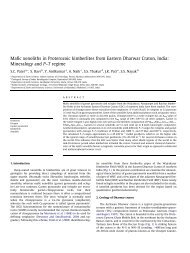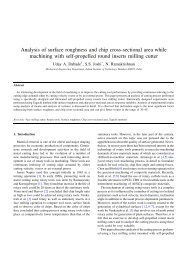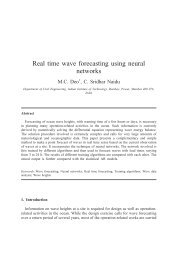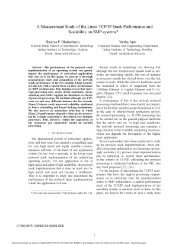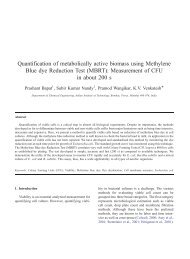Infrared signature studies of aerospace vehicles - DSpace at IIT ...
Infrared signature studies of aerospace vehicles - DSpace at IIT ...
Infrared signature studies of aerospace vehicles - DSpace at IIT ...
You also want an ePaper? Increase the reach of your titles
YUMPU automatically turns print PDFs into web optimized ePapers that Google loves.
3.3. Atmospheric transmission <strong>of</strong> IR and estim<strong>at</strong>ion <strong>of</strong> <strong>at</strong>mospheric IR-radiance . . . . . . . . . . . . . . . . . . . 224<br />
3.3.1. Estim<strong>at</strong>ion <strong>of</strong> <strong>at</strong>mospheric transmission <strong>of</strong> IR using LOWTRAN code . . . . . . . . . . . . . . . . . . 225<br />
3.3.2. Estim<strong>at</strong>ion <strong>of</strong> <strong>at</strong>mospheric IR-radiance using Berger’s model . . . . . . . . . . . . . . . . . . . . . . . . . 225<br />
3.4. Role <strong>of</strong> earthshine in IRSL . . . . . . . . . . . . . . . . . . . . . . . . . . . . . . . . . . . . . . . . . . . . . . . . . . . . . . 227<br />
4. Analysis and modeling <strong>of</strong> IR <strong>sign<strong>at</strong>ure</strong>s. . . . . . . . . . . . . . . . . . . . . . . . . . . . . . . . . . . . . . . . . . . . . . . . . . 228<br />
4.1. Analysis <strong>of</strong> powerplant and rear fuselage IR <strong>sign<strong>at</strong>ure</strong> . . . . . . . . . . . . . . . . . . . . . . . . . . . . . . . . . . . 228<br />
4.2. Analysis <strong>of</strong> plume IR <strong>sign<strong>at</strong>ure</strong> . . . . . . . . . . . . . . . . . . . . . . . . . . . . . . . . . . . . . . . . . . . . . . . . . . . 230<br />
4.3. Standard models for prediction <strong>of</strong> IR <strong>sign<strong>at</strong>ure</strong> . . . . . . . . . . . . . . . . . . . . . . . . . . . . . . . . . . . . . . . . 232<br />
4.3.1. NIRATAM . . . . . . . . . . . . . . . . . . . . . . . . . . . . . . . . . . . . . . . . . . . . . . . . . . . . . . . . . . . . 232<br />
4.3.2. SIRUS. . . . . . . . . . . . . . . . . . . . . . . . . . . . . . . . . . . . . . . . . . . . . . . . . . . . . . . . . . . . . . . . 232<br />
4.3.3. IRST. . . . . . . . . . . . . . . . . . . . . . . . . . . . . . . . . . . . . . . . . . . . . . . . . . . . . . . . . . . . . . . . . 232<br />
4.4. Adequacy <strong>of</strong> analysis methods vis-a` -vis experimental measurements . . . . . . . . . . . . . . . . . . . . . . . . . 232<br />
4.5. Lock-on versus lethal envelope and target susceptibility . . . . . . . . . . . . . . . . . . . . . . . . . . . . . . . . . . 233<br />
5. IR countermeasures (IRCMs) . . . . . . . . . . . . . . . . . . . . . . . . . . . . . . . . . . . . . . . . . . . . . . . . . . . . . . . . . 234<br />
5.1. Passive countermeasures . . . . . . . . . . . . . . . . . . . . . . . . . . . . . . . . . . . . . . . . . . . . . . . . . . . . . . . . 235<br />
5.1.1. Exhaust system. . . . . . . . . . . . . . . . . . . . . . . . . . . . . . . . . . . . . . . . . . . . . . . . . . . . . . . . . . 235<br />
5.1.2. Fuselage IRSS . . . . . . . . . . . . . . . . . . . . . . . . . . . . . . . . . . . . . . . . . . . . . . . . . . . . . . . . . . 237<br />
5.1.3. Limit<strong>at</strong>ions <strong>of</strong> IR suppressors . . . . . . . . . . . . . . . . . . . . . . . . . . . . . . . . . . . . . . . . . . . . . . . 238<br />
5.2. Active countermeasures . . . . . . . . . . . . . . . . . . . . . . . . . . . . . . . . . . . . . . . . . . . . . . . . . . . . . . . . . 239<br />
5.3. Counter–countermeasures . . . . . . . . . . . . . . . . . . . . . . . . . . . . . . . . . . . . . . . . . . . . . . . . . . . . . . . 240<br />
6. Summary and conclusions . . . . . . . . . . . . . . . . . . . . . . . . . . . . . . . . . . . . . . . . . . . . . . . . . . . . . . . . . . . 240<br />
6.1. Scope for future research . . . . . . . . . . . . . . . . . . . . . . . . . . . . . . . . . . . . . . . . . . . . . . . . . . . . . . . . 241<br />
Acknowledgements . . . . . . . . . . . . . . . . . . . . . . . . . . . . . . . . . . . . . . . . . . . . . . . . . . . . . . . . . . . . . . . . 242<br />
References . . . . . . . . . . . . . . . . . . . . . . . . . . . . . . . . . . . . . . . . . . . . . . . . . . . . . . . . . . . . . . . . . . . . . . 242<br />
1. Introduction<br />
Wars are increasingly driven by technology, and<br />
the aim is to use airpower extensively to gain<br />
early superiority, as this ensures higher Mission<br />
Attainment Measure. Survivability is an important<br />
aspect in warfare, because aircraft/helicopters are<br />
crucial to mission objectives. Since they are a crucial<br />
force in tactical warfare, military forces are constantly<br />
engaged in upgrading their fleet, to establish<br />
control over the airspace. In this process, they strive<br />
for best target detection, and search and tracking<br />
systems, to counter their enemy oper<strong>at</strong>ions. Aircraft/helicopter<br />
designers are making them stealthier<br />
by reducing their <strong>sign<strong>at</strong>ure</strong>s; viz. visual, aural,<br />
infrared (IR), and radio detection and ranging<br />
(RADAR). But more sensitive <strong>sign<strong>at</strong>ure</strong> detection<br />
systems are also being concurrently developed,<br />
thereby making <strong>sign<strong>at</strong>ure</strong> suppression requirements<br />
ever more stringent.<br />
Majority <strong>of</strong> aircraft/helicopters lost in tactical<br />
warfare have been destroyed by he<strong>at</strong>-seeking missiles.<br />
Further, passive detection and tracking is<br />
tactically superior to active, for comparable detection<br />
range. With increasing sensitivities <strong>of</strong> IRdetectors,<br />
analysis <strong>of</strong> passively emitted IR <strong>sign<strong>at</strong>ure</strong>s<br />
has emerged as an important component <strong>of</strong><br />
ARTICLE IN PRESS<br />
stealth technology. Availability <strong>of</strong> portable IRguided<br />
missiles to terrorist organiz<strong>at</strong>ions has further<br />
aggrav<strong>at</strong>ed the problem [1]. Consequently, IR<br />
<strong>sign<strong>at</strong>ure</strong> analysis is important for assessing aircraft/helicopter<br />
susceptibility.<br />
1.1. Background and motiv<strong>at</strong>ion<br />
219<br />
The following st<strong>at</strong>istics have forced the <strong>aerospace</strong><br />
community to incorpor<strong>at</strong>e IR <strong>sign<strong>at</strong>ure</strong> consider<strong>at</strong>ions<br />
in design and oper<strong>at</strong>ion <strong>of</strong> <strong>aerospace</strong> <strong>vehicles</strong>:<br />
Since 1967, IR guidance has been effectively used<br />
by MAN Portable Air Defence Systems (MAN-<br />
PADS) in all major wars and conflicts. These<br />
wars include South East Asian conflict (1963–<br />
1973), Yom Kippur war (1973), Soviet-Afghanistan<br />
conflict (1986), and Gulf war (1991).<br />
Over 40 civilian aircraft have been hit by<br />
MANPADS since 1970, causing 25 unserviceable<br />
crashes [2].<br />
From 1967 to 1993, 89% <strong>of</strong> all helicopter and<br />
aircraft downed were due to IR-guided missiles<br />
[3,4]. Therefore, it was st<strong>at</strong>ed by Powell in<br />
Ref. [5]: ‘No thre<strong>at</strong> is more serious to avi<strong>at</strong>ion<br />
than MANPADS’.



